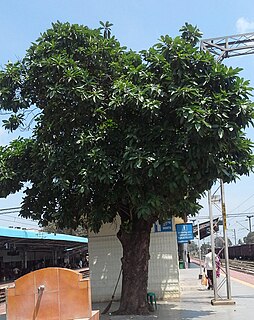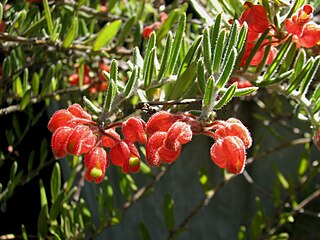
Morinda citrifolia is a fruit-bearing tree in the coffee family, Rubiaceae. Its native range extends across Southeast Asia and Australasia, and was spread across the Pacific by Polynesian sailors. The species is now cultivated throughout the tropics and widely naturalized. Among some 100 names for the fruit across different regions are the more common English names of great morinda, Indian mulberry, noni, beach mulberry, and cheese fruit.

Morinda is a genus of flowering plants in the madder family, Rubiaceae. The generic name is derived from the Latin words morus "mulberry", from the appearance of the fruits, and indica, meaning "of India".

Morinda tinctoria, commonly known as aal or Indian mulberry, is a species of flowering plant in the family Rubiaceae, native to southern Asia.

Morinda is a multi-level marketing company based in American Fork, Utah that sells Tahitian Noni juice and other products made from the noni plant. The company was founded in 1996 and has manufacturing facilities in Tahiti, Japan, China, Germany, and Utah. Morinda, formerly known as Tahitian Noni International and Morinda Bioactives, was a subsidiary of Morinda Holdings, Inc. prior to merging with and becoming a wholly owned subsidiary of New Age Beverages Corporation in December 2019.

Picea smithiana is a species of evergreen tree in the family Pinaceae family It is referred to by the common names morinda spruce and West Himalayan spruce, and is a spruce native to the western Himalaya and adjacent mountains, from northeast Afghanistan, northern Pakistan, India to central Nepal. It grows at altitudes of 2,400-3,600 m in forests together with deodar cedar, blue pine and pindrow fir.
Banksia fasciculata is a species of column-shaped shrub that is endemic to Western Australia. It has hairy stems, crowded, prickly leaves, yellow flowers and hairy fruit.

The long-tailed porcupine is a species of rodent in the family Hystricidae. It is monotypic within the genus Trichys, and is found in Brunei, Indonesia, and Malaysia.
Crithidia fasciculata is a species of parasitic excavates. C. fasciculata, like other species of Crithidia have a single host life cycle with insect host, in the case of C. fasciculata this is the mosquito. C. fasciculata have low host species specificity and can infect many species of mosquito.
Licania fasciculata is a species of plant in the family Chrysobalanaceae endemic to Panama. It is threatened by habitat loss.
Morinda asteroscepa is a species of plant in the family Rubiaceae. It is found in Malawi and Tanzania, but is on the IUCN Red List vulnerable species (Plantae).
Dendrocousinsia fasciculata is a species of plant in the family Euphorbiaceae. It is endemic to western and central Jamaica.

Ephedra fasciculata is a species of plant in the Ephedraceae family. Common names are Arizona ephedra, Arizona jointfir, and desert Mormon-tea.

Morindone is an anthraquinone compound obtained from various Morinda species, especially M. tinctoria, but also M. citrifolia. Its principal use is as a dye, but it has also been investigated for anticancer and microbial uses.

Tillandsia fasciculata, commonly known as the giant airplant or cardinal airplant, is a species of bromeliad that is native to Central America, Mexico, the West Indies, northern South America, and the southeastern United States. Within the United States, this airplant is at risk of extirpation from the Mexican bromeliad weevil, Metamasius callizona.

Grevillea saccata, commonly known as pouched grevillea, is a shrub which is endemic to the south-west region of Western Australia. It grows to between 0.25 and 0.5 metres in height. The red flowers usually appear from June to November in the species' native range. The species was formally described in 1870 by English botanist George Bentham in his Flora Australiensis.

Morinda royoc, commonly known as redgal, yawweed or cheese shrub, is a species of flowering plant in the family coffee family. It is native to Central America, South America, southern Florida, and the Islands of the Caribbean. It is a vine or sprawling shrub found in sandy or rocky coastal areas.

Morindeae is a tribe of flowering plants in the family Rubiaceae. The tribe contains about 165 species in 5 genera, found mainly in the tropics and subtropics.
Grevillea fasciculata is a shrub of the family Proteaceae that is endemic to the southwest of Western Australia.
Gynochthodes hollrungiana is a plant in the family Rubiaceae. Ii is found only in New Guinea.

Morinda Junction railway station is in Rupnagar district of Punjab state. It is fall under Northern Railway zone's Ambala railway division. It is single line electrified.












